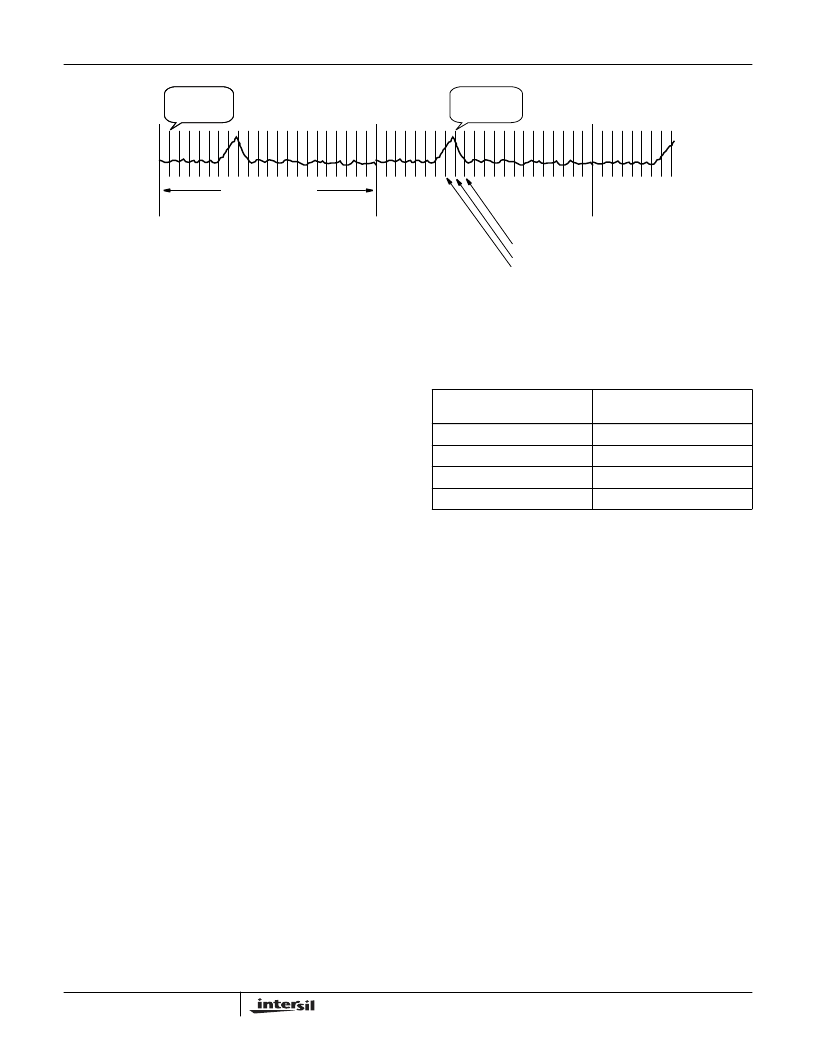- 您現(xiàn)在的位置:買賣IC網(wǎng) > PDF目錄384403 > HFA3860IV (HARRIS SEMICONDUCTOR) 11 Mbps Direct Sequence Spread Spectrum Baseband Processor PDF資料下載
參數(shù)資料
| 型號(hào): | HFA3860IV |
| 廠商: | HARRIS SEMICONDUCTOR |
| 元件分類: | 無繩電話/電話 |
| 英文描述: | 11 Mbps Direct Sequence Spread Spectrum Baseband Processor |
| 中文描述: | TELECOM, CELLULAR, BASEBAND CIRCUIT, PQFP48 |
| 文件頁數(shù): | 21/40頁 |
| 文件大小: | 250K |
| 代理商: | HFA3860IV |
第1頁第2頁第3頁第4頁第5頁第6頁第7頁第8頁第9頁第10頁第11頁第12頁第13頁第14頁第15頁第16頁第17頁第18頁第19頁第20頁當(dāng)前第21頁第22頁第23頁第24頁第25頁第26頁第27頁第28頁第29頁第30頁第31頁第32頁第33頁第34頁第35頁第36頁第37頁第38頁第39頁第40頁

4-21
The second form of correlator is the serial correlator bank used
for detection of the MBOK modulation. There is a bank of eight
8 chip correlators for the I Channel and another 8 for the Q
Channel. These correlators integrate over the symbol and are
sampled at the symbol rate of 1.375 MSPS. Each bank of
correlators is connected to a biggest picker that finds the
correlator output with the largest magnitude output. This finding
of 1 out of 8 process determines 3 signal bits per correlator
bank. The sign of the correlator output determines 1 more bit
per bank. Thus, each bank of correlators can determine 4 bits
at 1.375 MSPS. This is a rate of 5.5 Mbps. Only the I correlator
bank is used for BMBOK. When both correlator banks are
used, this becomes twice that rate or 11 Mbps.
Data Demodulation and Tracking
Description (DBPSK and DQPSK Modes)
The signal is demodulated from the correlation peaks tracked
by the symbol timing loop (bit sync) as shown in Figure 15.
The frequency and phase of the signal is corrected from the
NCO that is driven by the phase locked loop. Demodulation of
the DPSK data in the early stages of acquisition is done by
delay and subtraction of the phase samples. Once phase
locked loop tracking of the carrier is established, coherent
demodulation is enabled for better performance. Averaging
the phase errors over 16 symbols gives the necessary
frequency information for proper NCO operation. The signal
quality known as SQ2 is the variance in this estimate.
Configuration Register 15 sets the search timer for the SFD.
This register sets this time-out length in symbols for the
receiver. If the time out is reached, and no SFD is found, the
receiver resets to the acquisition mode. The suggested value
is # preamble symbols + 16. If several transmit preamble
lengths are used by various transmitters in a network, the
longest value should be used for the receiver settings.
Data Decoder and Descrambler Description
The data decoder that implements the desired DQPSK
coding/decoding as shown in Table 10. The data is formed
into pairs of bits called dibits. The left bit of the pair is the first
in time. This coding scheme results from differential coding
of the dibits. Vector rotation is counterclockwise for a positive
phase shift, but can be reversed with bit 5 or 6 of CR2.
For DBPSK, the decoding is simple differential decoding.
The data scrambler and de-scrambler are self synchronizing
circuits. They consist of a 7-bit shift register with feedback of
some of the taps of the register. The scrambler is designed
to insure smearing of the discrete spectrum lines produced
by the PN code.
One thing to keep in mind is that both the differential decoding
and the descrambling cause error extension. This causes the
errors to occur in groups of 4 and 6. This is due to two
properties of the processing. First, the differential decoding
process causes errors to occur in pairs. When a symbol error
is made, it is usually a single bit error even in QPSK mode.
When a symbol is in error, the next symbol will also be
decoded wrong since the data is encoded in the change from
one symbol to the next. Thus, two errors are made on two
successive symbols. In QPSK mode, these may be next to
one another or separated by up to 2 bits. Secondly, when the
bits are processed by the descrambler, these errors are
further extended. The descrambler is a 7-bit shift register with
one or more taps exclusive or’ed with the bit stream. If for
example the scrambler polynomial uses 2 taps that are
summed with the data, then each error is extended by a factor
of three. DQPSK errors can be spaced the same as the tap
spacing, so they can be canceled in the descrambler. In this
case, two wrongs do make a right, so the observed errors can
be in groups of 4 instead of 6. If a single error is made the
whole packet is discarded, so the error extension property has
no effect on the packet error rate.
T0 + 1 SYMBOL
CORRELATOR
OUTPUT
REPEATS
CORRELATION
PEAK
T0 + 2 SYMBOLS
T0
CORRELATOR OUTPUT IS
THE RESULT OF CORRELATING
THE PN SEQUENCE WITH THE
RECEIVED SIGNAL
SAMPLES
AT 2X CHIP
RATE
EARLY
ON-TIME
LATE
CORRELATION TIME
FIGURE 13. CORRELATION PROCESS
TABLE 10. DQPSK DATA DECODER
PHASE SHIFT
DIBIT PATTERN (D0, D1)
D0 IS FIRST IN TIME
0
00
+90
01
+180
11
-90
10
HFA3860
相關(guān)PDF資料 |
PDF描述 |
|---|---|
| HFA3860IV96 | 11 Mbps Direct Sequence Spread Spectrum Baseband Processor |
| HFA3861A | Direct Sequence Spread Spectrum Baseband Processor(直接序列擴(kuò)頻基帶處理器) |
| HFA3861B | Direct Sequence Spread Spectrum Baseband Processor(直接序列擴(kuò)譜基帶處理器) |
| HFA3861 | Direct Sequence Spread Spectrum (DSSS) baseband processor(直接序列擴(kuò)頻基帶處理器) |
| HFA3861IV | Direct Sequence Spread Spectrum Baseband Processor |
相關(guān)代理商/技術(shù)參數(shù) |
參數(shù)描述 |
|---|---|
| HFA3860IV WAF | 制造商:Harris Corporation 功能描述: |
| HFA3860IV96 | 制造商:INTERSIL 制造商全稱:Intersil Corporation 功能描述:11 Mbps Direct Sequence Spread Spectrum Baseband Processor |
| HFA3861 | 制造商:INTERSIL 制造商全稱:Intersil Corporation 功能描述:Direct Sequence Spread Spectrum Baseband Processor |
| HFA3861A | 制造商:INTERSIL 制造商全稱:Intersil Corporation 功能描述:Direct Sequence Spread Spectrum Baseband Processo |
| HFA3861AIN | 制造商:INTERSIL 制造商全稱:Intersil Corporation 功能描述:Direct Sequence Spread Spectrum Baseband Processo |
發(fā)布緊急采購,3分鐘左右您將得到回復(fù)。